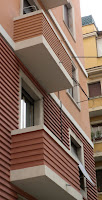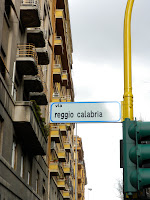The
Capitoline Hill is the smallest of Rome's seven hills, but it was the religious and political center of the city since its foundation more than 2500 years ago. The city legend of this hill starts with digging up a human skull (the word for head in Latin is caput) when foundation trenches were being made for a Temple of Jupiter. By the 16th century, the Latin Capitolinus had become Campidoglio in Italian. The English word capitol derives from Capitoline. (The name Capitol Hill for the location of the United States Congress in Washington D.C. was chosen by the founders of the US because of this ancient Roman location.)

At the southwest corner of the hill is the
Tarpeian Rock from which, in Roman times, condemned prisoners were hurled to their death. This practice continued until 1850 AD. In 1385 a Roman noble ,who was sentenced to death, gave two gold fiorins so that an image of the Virgin would be placed near this spot to give comfort to the condemned. By the early 1500s a chapel and hospital had been built on the site. (Ignatius of Loyola, Philip Neri and Aloysius Gonzaga are some of the people who cared for the sick here. It was at this site that St. Aloysius contracted the plague.) The hospital was demolished in 1936 but the church remains in use.

I have gone past the church of
Santa Maria della Consolazione on the Capitoline Hill many times. The piazza in front is cluttered with an open space parking area and the church looks neglected. What a surprise awaited me when I entered this church.

Above the high altar is Our Lady of Consolation. It is a 15th century fresco copy of the original medieval icon.

One of the side altars has a 13th century icon of Our Lady of Grace.

In the first chapel on the left is a marble relief by Raffaello da Montelupo (c. 1530) showing the Mystical marriage of St. Catherine. The upper part of this relief shows God the Father in a swirl of clouds and angels.

The first chapel on the right, the Capella Mattei, has frescoes with Scenes of the Passion (1556) by Taddeo Zuccari, including his masterpiece of the Crucifixion.


Other chapels, behind iron gates, have frescoes with scenes of the life of Mary and Jesus, the life of St. Andrew and St. Francis.
 Reflection
ReflectionSunday’s gospel form Luke is the account of the Transfiguration when the disciples were amazed when they awake from a sleep and saw Jesus in dazzling white talking with Moses and Elijah. There was a voice from a cloud that said “This is my chosen son; listen to him.” I was amazed when I entered the Church of Santa Maria della Consolazione. I never expected to be overwhelmed with so much beauty.

The marble image of God the Father in the clouds that I saw in the first chapel caused me to think about God’s command to listen to the words of Jesus. And the scenes from the passion in the last chapel provided a meditation on what Jesus did for all of us by his death on a cross. The journey of Lent is a special time to listen to the words of Jesus as recorded in scripture and meditate on Christ’s passion and death. It is a journey that leads to Easter and Resurrection!
Collect for the Second Sunday in LentO God, whose glory it is always to have mercy: Be gracious
to all who have gone astray from your ways, and bring them
again with penitent hearts and steadfast faith to embrace and
hold fast the unchangeable truth of your Word, Jesus Christ
your Son; who with you and the Holy Spirit lives and reigns,
one God, for ever and ever. Amen.From The Book of Common Prayer
 I found SPQR with this image of Romulus and Remus nursing from the she-wolf in Arezzo during our recent trip to Tuscany.
I found SPQR with this image of Romulus and Remus nursing from the she-wolf in Arezzo during our recent trip to Tuscany. Guido was a Benedictine monk who was born in Arezzo in 991. While a young monk on the Adriatic coast he noticed that singers had difficulty remembering Gregorian chants. He came up with a method for teaching the singers to learn chants in a short time. However, he attracted the hostility of the other monks at the abbey for doing this, and moved back to his home town of Arezzo. Arezzo had no abbey, but the bishop invited him to train and conduct the large group of cathedral singers.
Guido was a Benedictine monk who was born in Arezzo in 991. While a young monk on the Adriatic coast he noticed that singers had difficulty remembering Gregorian chants. He came up with a method for teaching the singers to learn chants in a short time. However, he attracted the hostility of the other monks at the abbey for doing this, and moved back to his home town of Arezzo. Arezzo had no abbey, but the bishop invited him to train and conduct the large group of cathedral singers.  While at Arezzo, he developed new technologies for teaching, such as staff notation and solfeggio, the "do-re-mi" scale.
While at Arezzo, he developed new technologies for teaching, such as staff notation and solfeggio, the "do-re-mi" scale.  The syllables for "do-re-me" were taken from the initial syllables of each of the first six musical phrases of "Ut queant laxis," the chant hymn for the feast of John the Baptist.
The syllables for "do-re-me" were taken from the initial syllables of each of the first six musical phrases of "Ut queant laxis," the chant hymn for the feast of John the Baptist.














































